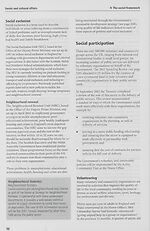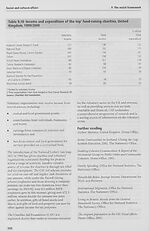Download files
Complete book:
Individual page:
Thumbnail gallery: Grid view | List view

Social and cultural affairs
9 The social framework
Table 9.9 Participation in voluntary
activities within the last 12 months,
by level of deprivation1 of home area.
England, 2001
Per cent
Informal Formal
volunteering volunteering
1 Least deprived areas 71 47
2 71 41
3 66 39
4 66 36
5 Most deprived areas 63 31
All respondents (number) 9,429 9,431
1 In accordance with the former Department of the Environment,
Transport and the Regions' Index of Multiple Deprivation.
Source: Citizenship Survey, Home Office
this at least once a month. These volunteers were
most likely to have raised money (22 per cent of
respondents) or organised or helped at an
activity or event (21 per cent). Sixty-seven per
cent of adults had volunteered informally (giving
unpaid help to an individual who was not a family
member) in the previous 12 months. A third did
this at least once a month. Informal volunteers
were most likely to have given someone advice
(31 per cent) or have looked after their property
or pets while they were away (28 per cent).
People living in the least deprived areas of
England were most likely to volunteer, formally or
informally, while those living in the most deprived
areas were least likely to volunteer (see Table 9.9).
Almost half of people living in the least deprived
areas formally volunteered compared with under a
third from the most deprived areas.
The Government is keen to encourage links
between the statutory, voluntary and community
sectors. The Youth Service is a partnership
between local government and voluntary
organisations concerned with the informal
personal and social education of young people
aged 11 to 25 (5 to 25 in Northern Ireland). Local
authorities manage their own youth centres and
clubs and provide most of the public support for
local and regional organisations.
Charities
The Charity Commission is the statutory
organisation responsible for the registration,
regulation and support of organisations that are
charitable under the law of England and Wales. It
does not make grants, but advises trustees about
administrative matters and has a statutory
responsibility to ensure that charities make
effective use of their resources.
In 2001/02, over 9,400 applications were received
for registration from organisations, of which 5,200
were accepted and placed on the Public Register of
Charities. There were approximately 186,000
registered charities in England and Wales at the
end of March 2002. Many other charitable
organisations are not required to register, for
example some churches and schools. Charities
elsewhere in the UK are not required to register
with a government organisation, but do need to
seek recognition of their charitable status with the
Inland Revenue, for tax purposes.
To become a registered charity in England and
Wales an organisation must have purposes that are
exclusively philanthropic, such as:
■ the relief of financial hardship;
■ the advancement of education;
■ the advancement of religion; or
■ other charitable purposes for the benefit of
the community, such as the promotion of
urban and rural regeneration or the relief of
unemployment.
The Charity Commission has the power to
investigate and supervise charities, including
measures to protect both charities and donors from
fraudulent fund-raisers. One of the Commission’s
duties is to investigate allegations of fraud or
dishonesty and evaluate them for cause for concern;
1,300 evaluations were carried out in 2001/02. Such
evaluations can lead to formal inquiries: over 200 of
these were completed during the same period.
Funding
At the end of March 2002, the total annual income
of all registered charities in England and Wales
was estimated at £27.8 billion. Approximately
6 per cent of registered charities receive nearly
90 per cent of the total annual income recorded,
while around 63 per cent have an income of
£10,000 or less a year and account for less than
1 per cent of the annual total. In 2000/01 the
average weekly donation made to charity was
£1.80 per household in the UK.
99
9 The social framework
Table 9.9 Participation in voluntary
activities within the last 12 months,
by level of deprivation1 of home area.
England, 2001
Per cent
Informal Formal
volunteering volunteering
1 Least deprived areas 71 47
2 71 41
3 66 39
4 66 36
5 Most deprived areas 63 31
All respondents (number) 9,429 9,431
1 In accordance with the former Department of the Environment,
Transport and the Regions' Index of Multiple Deprivation.
Source: Citizenship Survey, Home Office
this at least once a month. These volunteers were
most likely to have raised money (22 per cent of
respondents) or organised or helped at an
activity or event (21 per cent). Sixty-seven per
cent of adults had volunteered informally (giving
unpaid help to an individual who was not a family
member) in the previous 12 months. A third did
this at least once a month. Informal volunteers
were most likely to have given someone advice
(31 per cent) or have looked after their property
or pets while they were away (28 per cent).
People living in the least deprived areas of
England were most likely to volunteer, formally or
informally, while those living in the most deprived
areas were least likely to volunteer (see Table 9.9).
Almost half of people living in the least deprived
areas formally volunteered compared with under a
third from the most deprived areas.
The Government is keen to encourage links
between the statutory, voluntary and community
sectors. The Youth Service is a partnership
between local government and voluntary
organisations concerned with the informal
personal and social education of young people
aged 11 to 25 (5 to 25 in Northern Ireland). Local
authorities manage their own youth centres and
clubs and provide most of the public support for
local and regional organisations.
Charities
The Charity Commission is the statutory
organisation responsible for the registration,
regulation and support of organisations that are
charitable under the law of England and Wales. It
does not make grants, but advises trustees about
administrative matters and has a statutory
responsibility to ensure that charities make
effective use of their resources.
In 2001/02, over 9,400 applications were received
for registration from organisations, of which 5,200
were accepted and placed on the Public Register of
Charities. There were approximately 186,000
registered charities in England and Wales at the
end of March 2002. Many other charitable
organisations are not required to register, for
example some churches and schools. Charities
elsewhere in the UK are not required to register
with a government organisation, but do need to
seek recognition of their charitable status with the
Inland Revenue, for tax purposes.
To become a registered charity in England and
Wales an organisation must have purposes that are
exclusively philanthropic, such as:
■ the relief of financial hardship;
■ the advancement of education;
■ the advancement of religion; or
■ other charitable purposes for the benefit of
the community, such as the promotion of
urban and rural regeneration or the relief of
unemployment.
The Charity Commission has the power to
investigate and supervise charities, including
measures to protect both charities and donors from
fraudulent fund-raisers. One of the Commission’s
duties is to investigate allegations of fraud or
dishonesty and evaluate them for cause for concern;
1,300 evaluations were carried out in 2001/02. Such
evaluations can lead to formal inquiries: over 200 of
these were completed during the same period.
Funding
At the end of March 2002, the total annual income
of all registered charities in England and Wales
was estimated at £27.8 billion. Approximately
6 per cent of registered charities receive nearly
90 per cent of the total annual income recorded,
while around 63 per cent have an income of
£10,000 or less a year and account for less than
1 per cent of the annual total. In 2000/01 the
average weekly donation made to charity was
£1.80 per household in the UK.
99
Set display mode to:
![]() Universal Viewer |
Universal Viewer | ![]() Mirador |
Large image | Transcription
Mirador |
Large image | Transcription
The item on this page appears courtesy of Office for National Statistics and may be re-used under the Open Government Licence for Public Sector Information.
| Britain and UK handbooks > UK: The official yearbook of the United Kingdom of Great Britain and Northern Ireland > 2003 > (121) |
|---|
| Permanent URL | https://digital.nls.uk/204924680 |
|---|
| Attribution and copyright: |
|
|---|---|
| Description | Three volumes of 'UK: The official yearbook of the United Kingdom of Great Britain and Northern Ireland', published annually by the Office of National Statistics from 2002-2005. |
|---|---|
| Shelfmark | GII.11 SER |
| Description | Three titles produced by the British Government from 1954-2005 describing 'how Britain worked'. They are: 'Britain: An official handbook' (1954-1998), 'Britain: The official yearbook of the United Kingdom' (1999-2001), and 'UK: The official yearbook of the United Kingdom of Great Britain and Northern Ireland' (2002-2005). These 50 reports provide an overview of Britain's economic, social and cultural affairs, its environment, international relations, and the systems of government. They give an impartial summary of government policies and initiatives, and explain how public services are organised. |
|---|---|
| Additional NLS resources: |
|

